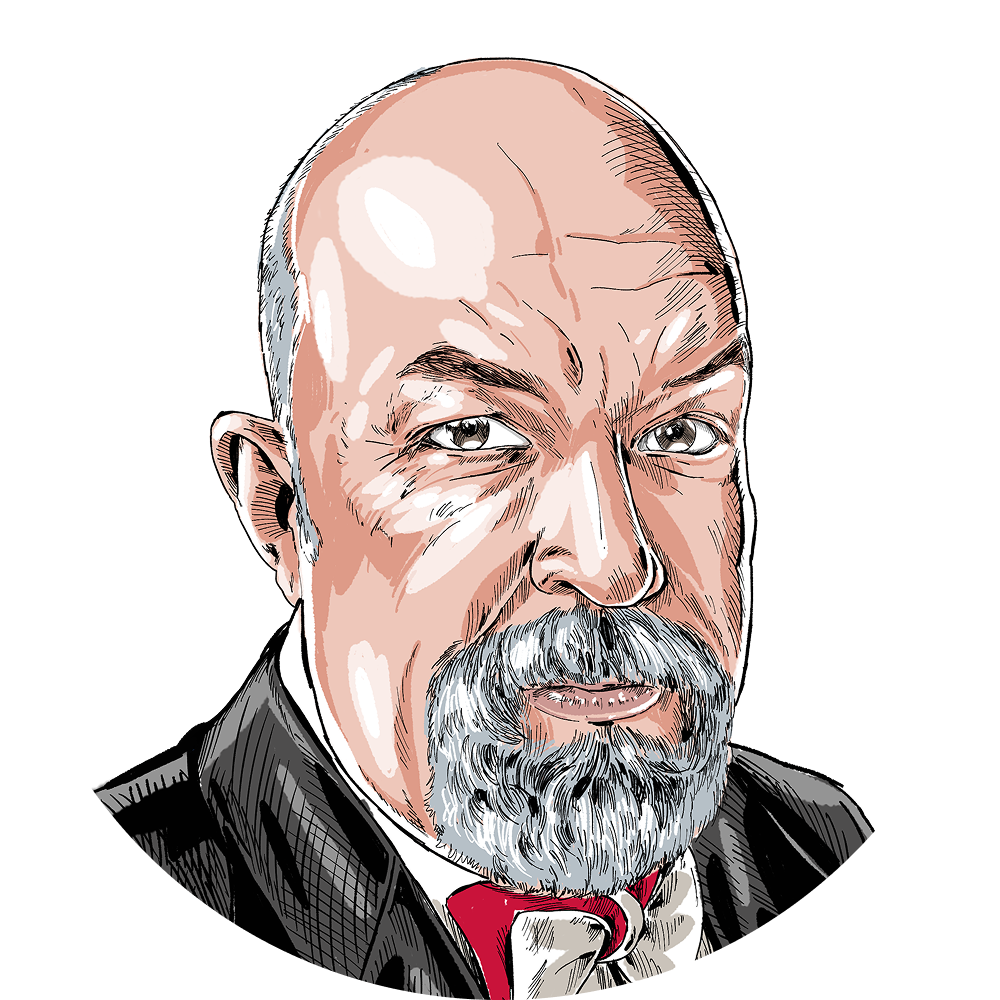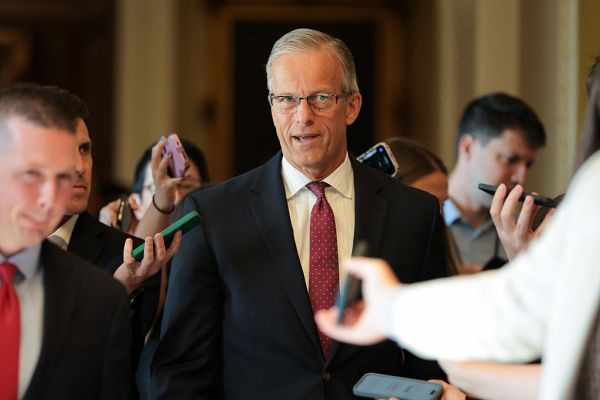My favorite example of how to think about probabilities versus outcomes is the guy who buys lottery tickets as his retirement plan. He never saves for his retirement but buys a lottery ticket every week. Of course, he doesn’t win—week after week, year after year, he buys a ticket and gets nothing in return. And then, a week before his retirement, he wins a $1 billion jackpot.
Now, he has a lot more money than his responsible friends who saved for their retirements. But it was still a bad plan—a stupid, irresponsible plan that just happened to work out.
Statistically unlikely things are not impossible things—just unlikely.
A famous example of this situation in politics is the 2016 election forecast from FiveThirtyEight, much mocked by people who don’t understand what that kind of analysis actually purports to offer. People who like Donald Trump and hate FiveThirtyEight like to pretend that Nate Silver et al. were spectacularly wrong in their 2016 estimate. They weren’t. They gave Donald Trump a 28.6 percent chance of winning the election—not a 0.00 percent chance. Things with better than one-in-four odds of happening happen all the time—they just happen less often than things with three-in-four odds. It was the smug, insufferable people who insisted Donald Trump had no chance in 2016 who were spectacularly wrong (guilty, Your Honor!), but those who were merely skeptical of his odds were right.
Writing in The Dispatch comments section, Patterico argues that Alvin Bragg’s case against Trump is much stronger than critics say and predicts that it will stand on appeal: “When that happens,” he asks, “will the critics finally acknowledge they were wrong?”
I suppose that will depend on whether they were, in fact, wrong.
There is a difference between fact claims and claims about matters of judgment. E.g.: If I were to have claimed that the gambler in my opening example was guaranteed, at the level of metaphysical certitude, never to win the lottery, then I would have been wrong. If, on the other hand, I had argued that relying on the lottery for a retirement plan is dumb and irresponsible, then I’d be right—even if he ended up winning the $1 billion jackpot.
I suppose there are legal critics out there arguing that Trump’s convictions will certainly and without question be overturned on appeal. But what I and other critics have argued is that Bragg’s case was based on a novel approach to the law, that it was not a matter of writing Trump a ticket for driving 99 mph in a 55 mph zone. Bragg’s case was tailor-made for Trump, and it may yet be that the appeals court goes in for a little sartor resartus. That doesn’t bother me as much as it does some people: I think it is less in the style of Lavrentiy Beria (“Show me the man, and I’ll show you the crime”) than it is something like how investigators go about securing permission to use a wiretap or other invasive investigatory measures against a suspected criminal. If you investigate someone you believe to be a career criminal, then you might even surprise yourself with what you finally come up with in the way of charges.
Contra Bragg’s critics, it is not always the case that we investigate crimes rather than investigating people—if that were the case, then we’d forgo a great many investigations of, say, organized crime figures with clean criminal records. Bragg’s investigation of Trump was premised on the belief that he probably had committed some kind of crime in the course of the Stormy Daniels hush-money matter and other shenanigans, and Bragg was able to show—to the unanimous satisfaction of a jury—that this was the case. Three cheers for that—but I am not sure that it is obvious that the outcome entirely sanctifies the strategy ex post facto or that it is obvious that skeptics were or are wrong to be skeptical. Maybe Bragg’s case has a 28.6 percent chance of surviving appeal; maybe it’s better or worse. Obviously, the matter of whether the convictions are upheld will tell us something about the wisdom of having brought the case—but it does not tell us everything.
We do not have to accept happy outcomes as dispositive evidence of the correctness of a course of action, that the end justifies the means. The problem is that the associated counterfactuals in these cases are usually unprovable. It seems to me, for example, that the best case the Trump element can make for having backed him in 2016 is that the two big wins of his presidency from the Republican point of view (judges and tax cuts) were worth the tradeoffs (attempted coup d’état, etc.). I don’t think that was, as a matter of fact, a good tradeoff, but, for the sake of argument, let’s say it was. There is every reason to believe that a President Marco Rubio or a President Ted Cruz would have delivered much the same results, if not superior ones, without such embarrassing inconveniences as Trump’s 2021 attempt to overthrow the government of the United States and illegitimately install himself as president. But I can’t prove that. All I can say is that, while Sen. Cruz has revealed himself to be a bootlicking sycophant, he remains a first-rate legal thinker and would, one assumes, have made an excellent judge of judges.
Conservatism is, to a considerable extent, a matter of one’s attitude toward risk. That is one of the reasons the Trump movement, like the Tea Party movement before it, ought not be understood as conservative but as radical—populist, right-wing, and radical.
In one aspect, conservatism is risk aversion rigorously thought-out and systematically applied to government and public life. It is a definite style. Progressives and radicals will set their sights on something good and then, having made the decision to pursue it, run headlong toward that goal, often setting aside procedures, norms, and constitutional restraints in pursuit of the good thing. Often, institutional guardrails will be treated with positive contempt, from Woodrow Wilson’s dismissal of the Constitution to Trumpists’ sneering at norms.
Conservatives, on the other hand, might agree about the goodness of the good thing but still prefer to pursue it slowly and gradually, or partly, or not yet. One reason for that is that we do not wish to damage our procedures and institutions by running roughshod over them; another is that experience teaches us that sometimes the good thing turns out not to be so good. In the 1950s, enlightened progressives were all-in on civil rights and desegregation—and they were right to be. But 40 years before that, progressives had been all-in on eugenics, including forced sterilizations. They were no less sure about the goodness of that project, which, they assured all, was blessed by science. In the 1930s, the most enlightened progressives had been all-in on Soviet-style central planning and authoritarian regimentation, another application of “science”—it is difficult to overstate the influence “scientific management” theories had on the progressivism (and general political culture) of that era. Progressives led the way on both women’s suffrage and on alcohol prohibition—a very mixed bag of policies.
Conservatives are faulted, not without reason, for slow-walking their way through the civil rights era when they weren’t being positively recalcitrant. Fair enough. There was no less fault in American progressives who ran as fast as they could into the embrace of Stalin et al. (and the history there is not as ancient as you might think), but we are asked to provide them with a moral get-out-of-jail-free card, to understand them as only “liberals in a hurry.” The same holds true for eugenics and “race science” and other pseudoscientific enthusiasms with which our progressive friends today would rather not be associated. To be generally skeptical of radical social changes or grand plans, as conservatives are, will sometimes put you on the wrong side of a good development, and it will sometimes put you on the right side of a bad development. One would think that the great twin political enthusiasms of the 20th century—the competing versions of national socialism practiced in the Third Reich and the Soviet Union—would be enough to put us off political enthusiasm entirely for a century or two. But that isn’t how the human heart operates.
We must consider that there were many things that needed changing, a need that found conservatives too slow-moving—or worse: Jim Crow in the United States and apartheid in South Africa; the abuses of anticommunist caudillos such as Francisco Franco and Augusto Pinochet; the various kinds of social exclusion practiced to different degrees against ethnic, religious, and sexual minorities; etc. As any serious social critic or investor knows, there are risks in risk aversion, too. It is possible—easy, even—to have too much of a mostly good thing.
Which brings us back to that funny word: wrong.
Consider the case of Sen. Barry Goldwater, who will be remembered mainly—and wrongly—as an enemy of the civil rights movement. Goldwater, in fact, had a proud record on the issue: Not only had he helped establish the Arizona chapter of the NAACP (which used to be a very Republican organization), he also helped fund Phoenix desegregation litigation out of his own pocket, and he pursued desegregation in both his business and government life. He voted for and actively supported most of the civil rights legislation of the 1950s. But he thought the 1964 Civil Rights Act was an overreaching and probably unconstitutional piece of legislation, warning that, if the federal government was given expansive powers to pursue desegregation—which he and other good-faith critics believed to be a worthy and enlightened goal—then those powers would be used in other less noble ways, with no obvious limiting principle.
Goldwater wasn’t wrong about that, as the current mess that is civil rights law attests. But neither was William F. Buckley Jr. wrong in his later confession that he and other conservatives had been mistaken (and sometimes worse than mistaken) in their obduracy about or indifference toward civil rights at the time when the question was most urgent. Goldwater was a man of principle, but he wasn’t only that, and his record is complicated by political self-interest (“hunt where the ducks are”) and miscalculations of domestic realpolitik.
Political calculation in the civil rights era can be perplexing in hindsight: Strom Thurmond had been seen as something of a moderate on racial issues—I mean moderate within his context—before his 1948 presidential campaign, during which he made segregation the centerpiece of his political identity, apparently believing that this was a savvy political move. Thurmond was one of the few prominent national Democratic figures of his kind to actually cross the aisle and join the Republican Party—and the one Republicans should have most readily rejected. Another miscalculation from the party of moral midgetry.
That we so often go wrong in our calculations doesn’t mean that we should stop calculating. That our plans so often go awry doesn’t mean that we should stop planning. What we need is to understand our limitations and begin from a position of moral and epistemic humility.
If you are looking to derive a program from these observations, you won’t have much luck. The best we can do is to embrace caution and prudence in the knowledge that these, too, can cause us problems when the dose is too large or is ill-timed. And so if we are wise we will in our political discourse stick to “conversation so nicely restricted to What Precisely and If and Perhaps and But.”
Words About Words
Noting our earlier discussion of the word tot—which means, among other things, a ration of rum once given to sailors in the British navy—a reader asks whether toddy, as in hot toddy, might be related.
Probably not. Whereas tot seems to have Norse roots, toddy is believed to be an Anglicization of a Hindi word for a warm alcoholic drink made from the fermented sap of palm trees. (Maybe I’m thirsty, but that sounds kind of good, if weird.) There are a great many words of Hindustani origin that made their way into English, largely by means of the British Empire: pajama, shampoo, cushy, punch, khaki, bungalow, jungle. These are all words of Indian or roughly Indian origin, mostly from Hindi or Sanskrit with some detours through Urdu and Persian.
Which raises a question I’ve received a few times: What’s the difference between Hindi and Hindustani? As one source remarks, it is as much a political question as a linguistic one. Hindustani refers to an Indo-Aryan language of Hindustan, which is another word for India, and, in that sense, Hindustani embraces both Hindi and Urdu, which are, for practical purposes, the same language with a different script. Modern Standard Hindi is, like Modern Standard English or Modern Standard Arabic, a kind of synthetic, literary language, a standardization of a number of different languages and dialects that each evolved in its own organic way over time. But while English has largely displaced anything that might really be considered a separate language (you don’t meet a lot of speakers of Saxon or Anglo-Norman), India’s non-Hindi languages are very much alive, with millions upon millions of speakers of Punjabi, Marathi, Konkani, etc. Sometimes, the various Indo-Aryan languages are referred to as “Hindustani languages,” but that isn’t exactly the same thing as the Hindustani language.
Or so I am given to understand. You get into some pretty hotly contested territory pretty quickly when it comes to Indian languages—or most any other language, especially in a multilingual society. If you want to start a linguistic fight, ask how closely Punjabi is related to Hindi and Urdu and see what happens.
Speaking of: Punjabi has about 150 million native speakers and is the most common language in Pakistan. It is an unusual language in that it is written with two different scripts: one common in India and a different one in Pakistan. The word for such a language is diagraphic.
Economics for English Majors
The economics behind the proposed Manhattan congestion tax—recently killed in an act of pure political cowardice by New York Gov. Kathy Hochul—is this: demand curves slope downward.
When conservatives want to criticize a particular tax or tax proposal, we will often say: “If you tax something, you’ll get less of it.” That’s true, and it is one of the reasons you don’t want very heavy taxes on labor, savings, investment, etc. There are times, though, when you do actually want less of something. But policymakers can be incoherent about that. Sure, taxes on alcohol or marijuana could raise a fair bit of revenue, but would you rather have people drinking more and smoking more weed, or would you rather have less of those things and less revenue? So-called sin taxes generally are not very good policies for precisely that reason: Nobody can agree about what they want from them.
You get the same kind of problem with congestion taxes, which are a form of sin tax—they probably aren’t a very good way to raise revenue for most cities and states, but they might reduce the number of private cars on the road if they are set high enough. There’s a sort of reverse Laffer Curve notion in there: If revenue from a congestion tax is growing, then you probably haven’t raised the rate high enough—assuming that what you really want is less traffic rather than more revenue. One of the many problems with such proposals is that they end up being riddled with exemptions, special favors, rate subsidies, etc., and end up neither being particularly good at producing revenue or at reducing the taxed activity.
The old Econ 101 supply and demand curves are not a perfect analytical tool, by any stretch of the imagination. But they will point you in the right direction.
I think of a family member who had a very successful consulting business—too successful, too many customers, too much travel, too many hours worked. What to do? The most straightforward economic answer in such a situation is to keep raising your prices until demand for your work is reduced to the level you are comfortable with. Raising prices is also a really good way of discovering exactly how much your clients value your work—and what aspects of your work your clients find most useful and productive. What you’ll often find is that your clients (or customers) don’t think about your work the way you do. I spent the first part of my journalism career mainly working as an editor and manager, and I thought that probably would be the main part of my work going forward. But the market had other ideas, and people started asking me to write more and at better rates, while my editing work fell off. People still wanted me to edit stuff for them, and so I raised my rates, at which point the market started saying: “No thanks on the editing. But could we get 800 words on x by 5 p.m.?”
Market conditions change, of course, and sometimes change rapidly, for all sorts of reasons. Right now, cities all over the country are watching—with mounting terror—as the commercial real estate market stumbles toward collapse, led by a cratering of demand for big-city office space exacerbated by persistent trouble in retail. New York City has basically the right idea at hand with its two-birds/one-stone approach to converting unwanted office space into housing, and, because it is a fundamentally sound idea, it’s probably not going to happen or will happen in a way that is idiotically expensive and market-distorting. For a long time, it looked like Manhattan rents went only in one direction: up. Then there was the financial crisis, and the Great Recession, and the COVID-19 pandemic. Now, the city has more office space than local businesses probably need, but good housing is still expensive due to artificial scarcity.
There is some precedent for programs to convert unused commercial space into residential stock: When he was mayor of Philadelphia, Ed Rendell enjoyed some real success with a tax-abatement program that encouraged the development of new condos and apartments. The program didn’t work out exactly as intended: The planners had thought that the new housing would attract young professionals but ended up attracting a lot of empty-nesters and retired people—older, affluent people who were great for things like the restaurant business. If Philly could have kept a lid on the crime and the chaos and maybe figured out a way to make its schools suck just a little bit less, it might have been a model for others. Rendell was at least smart enough to know that the city’s 10-year tax abatement didn’t really cost anything in real terms: Philly wasn’t giving up some existing revenue stream from new arrivals—it was losing population—but was trying to create conditions in which a future revenue stream might be created.
On the other hand, Philadelphia still burdens workers with a local wage tax of almost 4 percent. If you want less of something …
Furthermore …
About the discussion of grocery cart returns on this week’s episode of The Dispatch Podcast: While I generally endorse consulting Mrs. W about domestic matters, as the panel suggests, I generally do the grocery shopping, sparing the lady of the house the logistical challenges. I avoid the apparently common problem of kids locking themselves in the car by: not bringing four children with me, and—this is the important part!—not giving children the keys to the car, you savages.
Elsewhere …
You can buy my most recent book, Big White Ghetto, here.
You can buy my other books here.
You can see my New York Post columns here.
Please subscribe to The Dispatch if you haven’t.
You can check out “How the World Works,” a series of interviews on work I’m doing for the Competitive Enterprise Institute, here.
In Conclusion
If there is a worse hack in print than Gail Collins, I can’t think of who it might be.










Please note that we at The Dispatch hold ourselves, our work, and our commenters to a higher standard than other places on the internet. We welcome comments that foster genuine debate or discussion—including comments critical of us or our work—but responses that include ad hominem attacks on fellow Dispatch members or are intended to stoke fear and anger may be moderated.
With your membership, you only have the ability to comment on The Morning Dispatch articles. Consider upgrading to join the conversation everywhere.